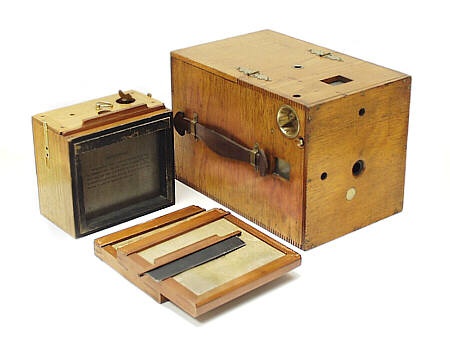|
|



Copyright ©2000 by Rob Niederman - ALL RIGHTS RESERVED
Return to the Solid Body & Box Cameras page
This first version Blair Hawk-Eye Detective camera is the exposed wood model of
the well known detective hand camera. Later models included a second
'Improved' exposed wood version and leather covered versions with various lens
combinations.
The Hawk-Eye Detective Camera was a continuation of the same camera originally made by The Boston Camera Company from c.1888-90. Blair acquired The Boston Camera Company in 1890. Exposed wood models are becoming increasingly scarce yet are highly desirable, handsome cameras with brass trim.
Although the term 'Detective' is part of the camera's name, the Blair Hawkeye Detective is not a true spy camera as many people would like to believe. The term 'Detective' has its roots to around 1881 when the first hand cameras were introduced: simple bellows cameras placed inside a carrying case or "bellows-in-a-box." This was originally done to make candid snapshots.
The Hawk-Eye Detective Camera was a continuation of the same camera originally made by The Boston Camera Company from c.1888-90. Blair acquired The Boston Camera Company in 1890. Exposed wood models are becoming increasingly scarce yet are highly desirable, handsome cameras with brass trim.
Although the term 'Detective' is part of the camera's name, the Blair Hawkeye Detective is not a true spy camera as many people would like to believe. The term 'Detective' has its roots to around 1881 when the first hand cameras were introduced: simple bellows cameras placed inside a carrying case or "bellows-in-a-box." This was originally done to make candid snapshots.
Multi-Lens Cameras | View Cameras | Self-Casing Cameras | Solid Body Cameras | References & Advertisements
Home | What's New | Show Schedule | Wanted | For Sale | Links | Site Map | Email
Home | What's New | Show Schedule | Wanted | For Sale | Links | Site Map | Email
Blair Hawk-Eye Detective, c.1891
Blair Camera Company, Boston, Mass.
Blair Camera Company, Boston, Mass.
People eventually figured out that most anyone seen carrying a box with a hole in the front was actually holding a camera. Eventually the entire
effort of making candid, detective style pictures became more difficult because people would pose for a picture. In the end, the term 'Detective'
became a carryover from those earlier times more or less describing a camera style. The Blair Hawkeye Detective is not a "bellows-in-a-box" camera
because the camera itself cannot be removed from a carrying case for ordinary work. However Blair did offer a "bellows-in-a-box" style camera in
1884 called the "Boston Detective Camera."
The Hawk-Eye Detective has a rear chamber to store several plate holders. By designing a fully enclosed darkened chamber, composing and focusing the image could be done without a focusing cloth. Removal of a rear wood panel allowed the user to view the ground glass image. Internal bellows focusing was done by means of a rear brass knob. A roll film holder option was also available as an alternative to using dry plates.
Note: The short darkslide shown on top of the first plateholder is used as a "light-trap" for rollfilm exposures. It replaces the large darkslide (shown inside the rollfilm holder) when exposures are made.
The Hawk-Eye Detective has a rear chamber to store several plate holders. By designing a fully enclosed darkened chamber, composing and focusing the image could be done without a focusing cloth. Removal of a rear wood panel allowed the user to view the ground glass image. Internal bellows focusing was done by means of a rear brass knob. A roll film holder option was also available as an alternative to using dry plates.
Note: The short darkslide shown on top of the first plateholder is used as a "light-trap" for rollfilm exposures. It replaces the large darkslide (shown inside the rollfilm holder) when exposures are made.
First Version (short body variation) For 4" x 5" plates.
Serial No.43. Shown with rollfilm holder and plateholders.
Serial No.43. Shown with rollfilm holder and plateholders.